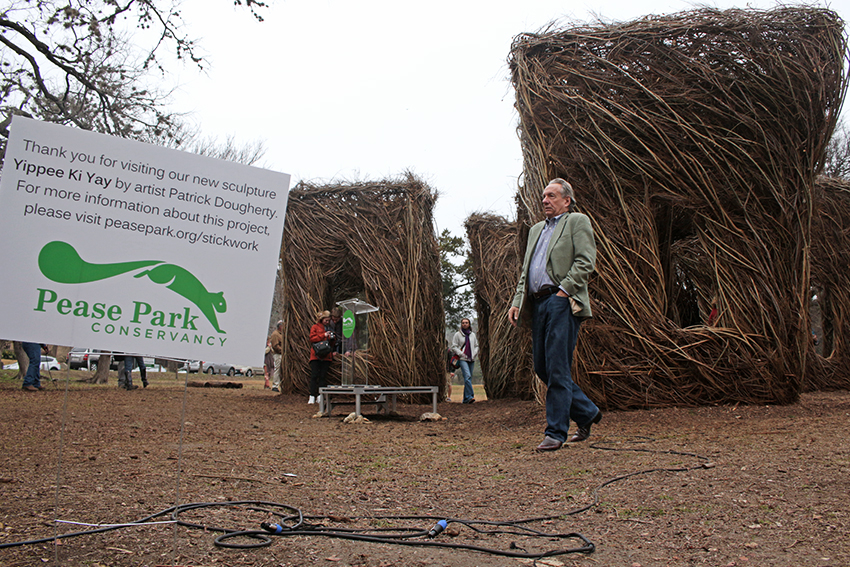A mile from campus, five twisted, leaning towers stand in the middle of Pease Park. Warped and furnished with windows and walkways, the wooden structures create the illusion of being in a small maze.
Equipped with jackets and umbrellas, dozens of Austinites, young and old, gathered at Pease Park Saturday afternoon to witness the ceremonial revealing of the community’s latest art installation. The stick-woven, Dr. Seuss-esque structures titled “Yippee Ki Yay,” designed by renowned sculptor Patrick Dougherty, have been turning heads for about a week. Commissioned by the Pease Park Conservatory with the help of fundraising and private donations, “Yippee Ki Yay” was designed to bring more visitors to the park as the conservatory gets ready to carry out a multi-phase renovation plan.
According to the CEO of Pease Park Conservatory Kristen Brown, Pease Park will start renovating the area known as Kingsbury Commons sometime next year. Just over $100,000, this addition is separate from the park’s future renovation plans, meaning that without the help from the community, the art piece wouldn’t have come to fruition.
“When I look at this sculpture, it is symbolic of how many people it took to bring it here both donation-wise and volunteer-wise.” Brown said.
Dougherty, the artist behind “Yippee Ki Yay,” is responsible for similar sculptures all over the world. He says his use of volunteers to construct his art helps tie each piece to the community.
“Using volunteers is central to the work,” Dougherty said. “It helps embed the piece in the community. If you have people work on it in that community, they feel a little more feelings for it and they put their heart and effort in it.”
In terms of the sculpture’s name, Dougherty said he was inspired by the Texas hill country where the invasive Roosevelt Weed used for the sculpture was gathered from.
“We decided that we needed a cowboy’s salutation,” Dougherty said. “People like to say it.”
Austin resident Bill Dorman, a 72 year-old retired contractor, is not only one of the volunteers responsible for building the structure, but also one of the few who have been tasked with its upkeep, as the towers are expected to deteriorate over the course of the next two years.
Dorman lives just down the street from the park, and he, along with a few others, will be consistently trimming stray twigs so that the sculpture remains safe for visitors. For the veteran contractor, building a structure was nothing new, but never has he worked on anything quite like this.
“Everything I ever did was utilitarian,” Dorman said. “It always had aesthetic elements, but it’s always shelter. This has no utilitarian value whatsoever. We had scaffolding, and ladders, and tools, and it’s just lots and lots of work to build something, essentially just for the hell of it. And that’s just so cool.”
Business sophomore Madison Mohns was at the park. After seeing the event on Facebook, she was instantly drawn to the sculpture. Unknown to Mohns before the event, Dougherty had visited her hometown of Napier, Illinois when she was a child, making the current art piece reminiscent of home.
“I thought why not come back and relive my childhood a little bit,” Mohns said.
The sculpture, now standing in its new home, is ready to receive curious visitors of all ages. Though spending over $100,000 on an installation that won’t last more than a couple of years, Dorman quotes something Dougherty said during a lecture at his museum.
“Somebody asked him what you think about the fact that your work is temporary,” Dorman said. “He said, “Everything is temporary. I mean (being temporary is) part of it.’”















